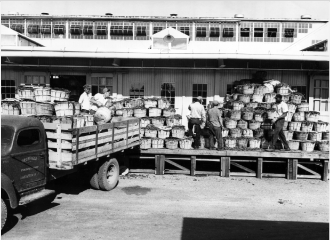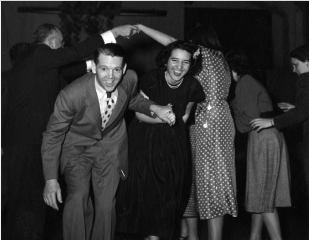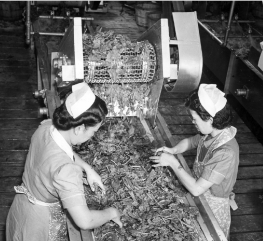
During the fall 2015 semester, students in the "Public Histories of Detention and Mass Incarceration" course were asked to curate a series of images from the more than 2,500 photos that are available online through the Rutgers University Community Repository, which was accessioned from the Seabrook Educational and Cultural Center. The collection is comprised mainly of pictures taken by the full-time photographic department that Seabrook Farms employed during the height of production in the 1940s and 1950s. In 1990, John Fuyuume and Charles Nagao discovered the photos in the basement of James Seabrook, C.F.'s grandson, and, realizing their value, saved them from destruction.
Students were instructed to use these images to interpret an element or aspect of life at Seabrook Farms, whether in relation to labor, captivity, community relations, social life, race, gender, or other relevant themes. Because these photos were taken by the company, contemporary viewers are tasked with deciphering and questioning what Seabrook Farms officially intended to depict.
The essays in this section represent the perspectives, interpretations, and analytical focuses of the authors. Although they have been edited for clarity by Professor Andrew Urban and the undergraduate research assistants who worked on this exhibit after the semester's end - Sabah Abbasi and Amy Clark - whenever possible they have been left in their original forms. Our hope is that these essays, and the primary sources they grapple with, will serve as the basis for additional discussion and debate, and continue to spur new ways of approaching Seabrook Farms' layered and complex history.
During the fall 2015 semester, students in the "Public Histories of Detention and Mass Incarceration" course were asked to curate a series of images from the more than 2,500 photos that are available online through the Rutgers University Community Repository, which was accessioned from the Seabrook Educational and Cultural Center. The collection is comprised mainly of pictures taken by the full-time photographic department that Seabrook Farms employed during the height of production in the 1940s and 1950s. In 1990, John Fuyuume and Charles Nagao discovered the photos in the basement of James Seabrook, C.F.'s grandson, and, realizing their value, saved them from destruction.
Students were instructed to use these images to interpret an element or aspect of life at Seabrook Farms, whether in relation to labor, captivity, community relations, social life, race, gender, or other relevant themes. Because these photos were taken by the company, contemporary viewers are tasked with deciphering and questioning what Seabrook Farms officially intended to depict.
The essays in this section represent the perspectives, interpretations, and analytical focuses of the authors. Although they have been edited for clarity by Professor Andrew Urban and the undergraduate research assistants who worked on this exhibit after the semester's end - Sabah Abbasi and Amy Clark - whenever possible they have been left in their original forms. Our hope is that these essays, and the primary sources they grapple with, will serve as the basis for additional discussion and debate, and continue to spur new ways of approaching Seabrook Farms' layered and complex history.
Race, Gender, and Ethnicity
| Social Life at Seabrook Farms | Sabah Abbasi |
| Gender and Labor in the Post-War Era | Amy Clark |
| Teaching Diversity: Japanese Americans at Seabrook | Sonya Dalton |
| Estonians and their Experience of Relocation to Seabrook Farms | Dmitri Orlov |

Company Town
| Building the Image of an Empire | Janna Aladdin |
| The Nurseries of Seabrook Farms | Morgan Dodds |
| The Work That Went Into the Work | Emma Pallarino |
| Paternal Instinct at Work | Philip Ripperger |
| The Duality of Life in Seabrook Farms | Hangrui Wan |

Community
| Production and Propaganda: Scenes of the Interior | Glenna Gray |
| Seabrook - A Community Like Any Other? | Karenjot Kaur |

Life, Labor, and Wartime Legacies
| Niall Conway | |
| Captive Patriotism and Seabrook's Secured Accommodations | Michael Denis |
| Internment, Innocence, and Integration: Childhood at Seabrook Farms in the Post-WWII Era | Austen-Leigh DePinto |
| Boy Scouts of Seabrook | Erin Weinman |
